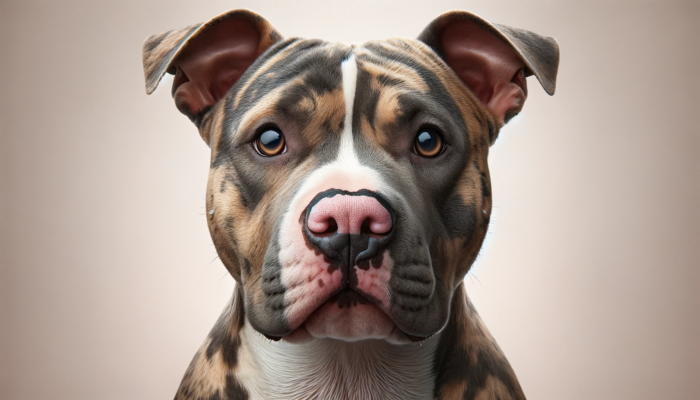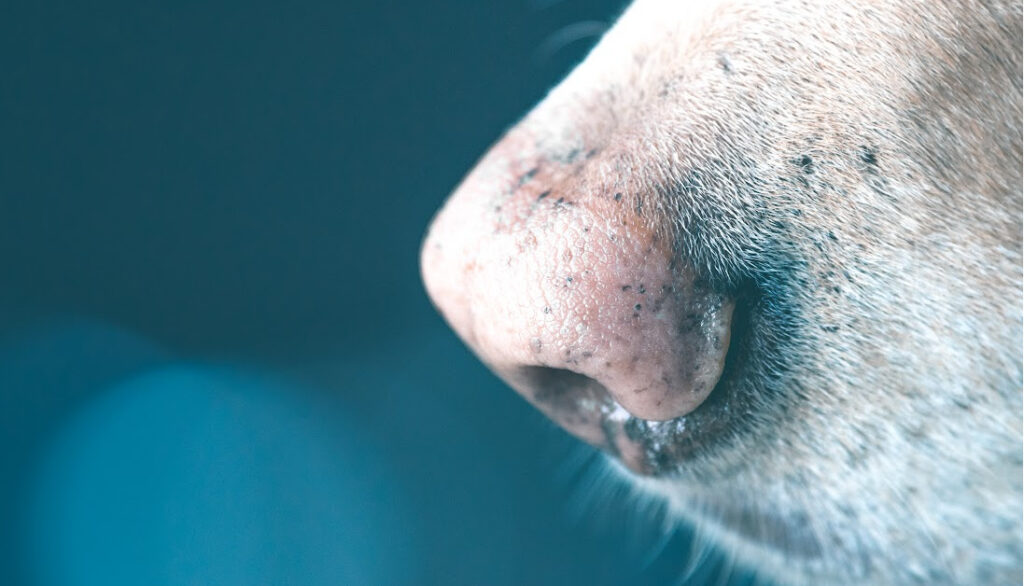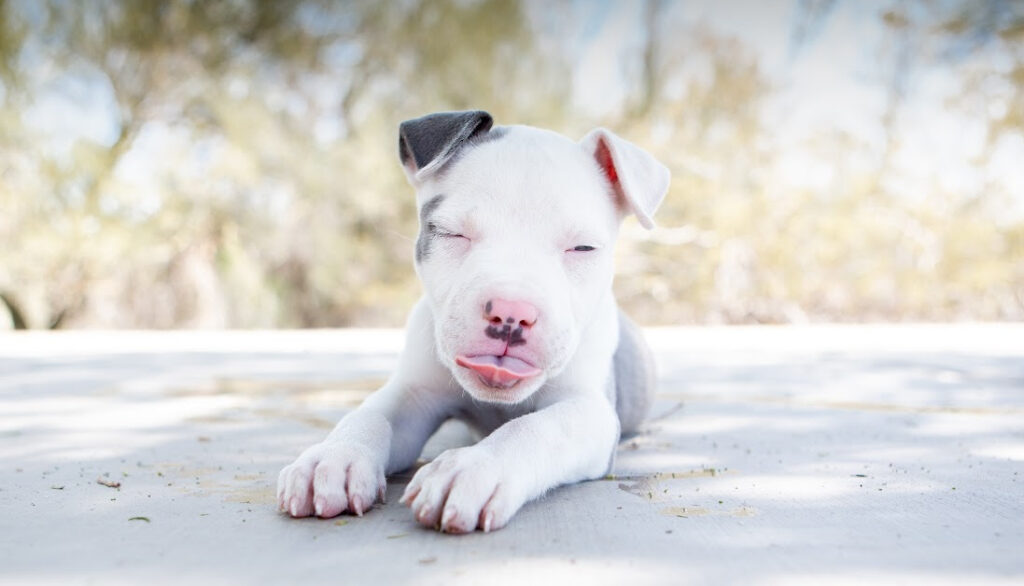If there’s one thing that can make a dog’s face even more adorable, it’s a pink nose. These little rosy snouts are a delightful feature that adds an extra pinch of cuteness to our furry friends. But have you ever wondered why some dogs have pink noses? As a veterinarian, I’m here to give you the lowdown on these charming pink nose dog breeds.

The color of a dog’s nose, much like the color of our skin, is determined by pigmentation. This pigmentation is influenced by a variety of factors, including genetics and sun exposure. However, some dog breeds naturally have less pigmentation in their noses, resulting in a pink or light-colored nose. While it might seem purely aesthetic, this trait does have some health implications, such as increased sensitivity to sunburn. But don’t worry, I’ll also provide you with some tips to keep your pink-nosed pup safe and healthy.
American Pit Bull Terriers and Labrador Retrievers are just two examples of breeds that can sport this distinctive feature. Beyond their nose color, these breeds have other unique physical characteristics as well as distinct personality traits. For instance, both breeds are known for their friendly and loyal nature.
Caring for a pink-nosed dog requires a bit of extra attention, particularly in terms of sun protection. Regular grooming and specific skin care can also help keep their noses healthy. If you’re considering adding a pink-nosed pup to your family, it’s important to understand the role of breeders in maintaining this trait and the genetic factors involved.
So, if you’re drawn to the allure of pink-nosed pups and are considering adopting one, or you’re just curious about the science behind those rosy snouts, read on. We’re about to delve deep into the charming world of pink nose dog breeds.

The Science of Pink Noses in Dogs
Do you ever wonder why your fur baby has such a charming pink nose? The answer lies in the captivating world of genetics and pigmentation, a fascinating journey that reveals the marvel of nature in our beloved pets. Let’s embark on this exploration together, understanding the scientific magic that gives birth to the distinct pink noses in some dog breeds.
Pigmentation and Its Role in Nose Color
The color of a dog’s nose, including that eye-catching pink, is all about pigmentation. The primary pigment, melanin, is what determines the color of a dog’s coat, eyes, and of course, their nose. A high concentration of melanin results in a black or brown nose, while a lower concentration leads to a lighter color, like pink.
What’s truly fascinating is how this pigmentation process works. Melanocytes, specialized skin cells, produce melanin in response to sunlight. These melanin-filled cells are then transferred to keratinocytes, which are the building blocks of your dog’s skin, hair, and yes, the nose! The more melanin these keratinocytes receive, the darker the nose color.
There are a few reasons why a dog might have less melanin in their nose, leading to a pink hue. Sometimes it’s due to a condition called ‘snow nose’ or ‘winter nose,’ where dogs’ noses lighten in the colder months and darken again when the weather warms up. In some breeds, a pink nose is entirely natural and is just part of their genetic makeup.
Health Implications of Pink Noses
When it comes to the health of pink nose dog breeds, it’s important to note that while a pink nose is typically harmless, it does come with some additional considerations.
Because of the lower melanin levels, pink-nosed dogs have less natural protection against the sun’s harmful UV rays. This makes them more susceptible to sunburn, which can be quite painful for your pup and in severe cases, lead to skin cancer.
However, do not let this alarm you. Armed with the right knowledge and precautions, you can keep your rosy-nosed friend safe and healthy. One simple but effective measure is using a vet-approved sunscreen for dogs during prolonged sun exposure.
Another aspect to consider is that a sudden change in nose color should not be ignored. If your dog’s nose changes from black or brown to pink, it’s worth a trip to the vet to rule out any underlying health issues.
While there’s no denying the appeal of a pink nose, understanding the science and health implications behind it equips us with the knowledge to take the best possible care of our pink-nosed pups. Remember, your dog’s health and well-being is always the top priority, and a well-informed pet parent is the best pet parent you can be.
Stay tuned for more as we delve into the specific breeds with pink noses and discover their unique characteristics and personalities. The charming world of pink-nosed dogs is full of surprises, and we’re just getting started!
The Allure of Pink-Nosed Pups
There’s something uniquely adorable about a dog with a pink nose. Also known as a “Dudley nose” in the dog world, pink noses lend a certain charm and innocence to a pup’s face that can be irresistibly endearing. It’s not just the cuteness factor either, dogs with pink noses often have a friendly, playful temperament that makes them great companions.
Understanding the Genetics Behind Pink Noses
The color of a dog’s nose is determined by its genes. Typically, dogs have black or brown noses, thanks to a pigment called melanin. However, some dogs lack this pigment in their noses due to a genetic trait, resulting in a pink or light-colored nose.
List of Pink Nose Dog Breeds
While any breed can potentially have a pink nose due to genetic variations, some breeds are more likely to have pink noses than others. Here are a couple of well-known breeds characterized by their pink noses:
American Pit Bull Terrier
American Pit Bull Terriers can have pink noses, a trait that is often sought after among enthusiasts of this breed. Their noses can range from a light pink to a deep, rosy hue. The pink nose is a distinct feature that contrasts beautifully with their typically solid-colored coat.
Labrador Retriever
Although not as common as in American Pit Bull Terriers, some Labrador Retrievers can also have pink noses. This trait is usually seen in yellow Labs, where the lack of pigmentation gives them a soft, pinkish nose. It’s a charming feature that adds to their playful and friendly demeanor.
Distinguishing Features of Pink-Nosed Breeds
Of course, a pink nose isn’t the only thing that makes these breeds special. Here are a few other notable features:
Physical Characteristics Beyond Nose Color
Both American Pit Bull Terriers and Labrador Retrievers are medium to large-sized dogs with strong, muscular bodies. Pit Bulls are known for their broad chests and powerful jaws, while Labs are recognized for their thick, otter-like tails and water-resistant coats.
Temperament and Personality Traits
These breeds are also known for their friendly and playful nature. Pit Bulls, contrary to some common misconceptions, are extremely affectionate and loyal dogs. Similarly, Labrador Retrievers are known for their outgoing, even-tempered personalities and are often praised for their intelligence and trainability.
Caring for Pink-Nosed Dogs
One important thing to remember when caring for dogs with pink noses is that they can be more susceptible to sunburn due to the lack of pigmentation. Therefore, they may need extra protection when outside, such as a dog-friendly sunscreen or shade-providing accessories. Regular grooming and skin care are also essential to keep their noses healthy.
So, if you’re in love with the appeal of pink-nosed pups and are considering adding one to your family, remember that these are fascinating breeds with a lot more to offer beyond their charming noses. As with any dog breed, they deserve dedicated care, love, and attention in order to live their happiest and healthiest life.
Distinguishing Features of Pink-Nosed Breeds
Physical Characteristics Beyond Nose Color
While the pink nose is an adorable and distinct characteristic, these breeds have much more to offer. Let’s take a closer look at some of the physical traits that make these pink-nosed breeds stand out from the crowd.
The American Pit Bull Terrier, besides its pink nose, has a muscular build and a short, shiny coat. This breed comes in a wide array of colors, with its most apparent physical trait being its strength and athletic ability. The Pit Bull’s eyes are another unique feature, usually almond-shaped and set well into the skull, providing a keen gaze.
On the other hand, Labrador Retrievers have a broader, block-shaped head with expressive eyes that often reflect their kind and intelligent nature. They have a dense, water-resistant coat that can vary in color, including yellow, black, and chocolate. They also have a distinctive ‘otter’ tail which is thick at the base and tapers towards the end.
Temperament and Personality Traits
A dog’s character is just as vital, if not more, than their physical attributes. These pink-nosed breeds have some personality traits that make them unique and beloved by many.
American Pit Bull Terriers are known for their courageous and intelligent nature. They are affectionate with family, including children, and tend to be very friendly, even with strangers. This breed is energetic and requires regular exercise to keep them mentally and physically stimulated.
Labrador Retrievers, similar to Pit Bulls, are known for their friendly demeanor and high energy levels. They are incredibly loyal, trainable, and love to play, making them an excellent choice for families. Labradors are also known for their love of water and retrieving, thanks to their hunting heritage.
In both breeds, the color of their nose doesn’t affect their personality or temperament. Instead, it’s the love, care, and training they receive from their human companions that truly shape their behavior.
Remember, whether you’ve fallen in love with the friendly Lab or the courageous Pit Bull, it’s essential to consider more than just their adorable pink noses. Their unique physical characteristics and personality traits make these breeds truly special, ensuring they will be a loving and loyal addition to any family.
SEO Key Terms:
Pink nose dog breeds, American Pit Bull Terrier, Labrador Retriever, physical characteristics, temperament, personality traits

Sun Protection for Sensitive Noses
The adorable pink noses of certain dog breeds are not just a cute feature. They are also a sign of a lack of pigmentation, which makes them more sensitive to the sun. Dogs with pink noses are more prone to sunburns and skin cancer, particularly squamous cell carcinoma. Therefore, it’s crucial to take extra steps to protect your rosy-nosed friend from harmful UV rays.
One of the easiest ways to do this is by applying a pet-safe sunscreen to your dog’s nose. There are many products on the market specifically designed for this purpose, and they are generally safe for dogs to lick off. When applying, be sure to cover the entire nose, especially the ridge where the skin is thinnest.
Another method is to limit your dog’s exposure to the sun, especially during peak hours (10 a.m. to 4 p.m.). You might consider scheduling walks and outdoor playtime in the early morning or late afternoon when the sun is less intense. Additionally, providing shaded areas in your backyard or at the dog park can help shield your dog from the sun.
Grooming and Skin Care Tips
Beyond sun protection, there are other ways to care for your pink-nosed pup’s skin. Regular grooming is essential to maintaining their skin and coat health. Here are some tips for keeping your dog’s skin in top shape:
– Regular Baths: Bathing your dog regularly can help remove dirt and debris from their skin and coat. However, be sure not to overdo it, as too frequent bathing can strip the skin of its natural oils, leading to dryness and irritation. Aim for a bath every 4-6 weeks, and always use a gentle, dog-specific shampoo.
– Moisturize: Just like human skin, dog skin can benefit from moisturizing. There are dog-safe moisturizers available that can help keep your pup’s skin hydrated, especially in dry or cold weather.
– Brushing: Regular brushing not only keeps your dog’s coat looking shiny and healthy, but it also stimulates the skin and can help distribute natural oils. This can be particularly beneficial for dogs with pink noses, as their skin can be more prone to dryness.
– Check-ups: Regular vet check-ups are crucial for all dogs, but especially for breeds with pink noses. Your vet can check for any signs of skin issues, including sun damage, and provide advice on how to best protect your dog’s skin.
Caring for a dog with a pink nose requires some extra steps, but with the right care and attention, you can help ensure your dog’s nose stays healthy and pink. Remember, every dog is unique, and what works for one may not work for another. Always consult with your vet before making changes to your dog’s skin care routine.
Breeding and Genetics of Pink-Nosed Dogs
Many people wonder why some dogs have pink noses. The answer lies in the fascinating world of dog genetics and breeding. Let’s dive deeper into the inheritance patterns of nose pigmentation and the role breeders play in maintaining nose color.
Inheritance Patterns of Nose Pigmentation
Genetics plays a vital role in determining the color of a dog’s nose. The melanin pigment, responsible for coloration in dogs, comes in two forms: eumelanin (black/brown pigment) and pheomelanin (red/yellow pigment).
Typically, the default color in dogs is black, including the nose. However, some dogs carry the “liver” or “d” gene, which dilutes the black pigment to a brownish color. If a dog is homozygous for this gene, meaning it has two copies, it can have a brown or ‘liver’ colored nose.
Contrary to popular belief, a pink nose doesn’t mean a dog is albino. Albinism, a complete lack of pigment, is extremely rare in dogs. Instead, pink noses often result from reduced melanin production, which can be caused by various genetic factors. Certain breeds are more prone to this, as they have been selectively bred for their lighter pigmentation.
The Role of Breeders in Maintaining Nose Color
Dog breeders play a significant role in maintaining nose color, especially when it comes to breeds known for their pink noses. They achieve this through selective breeding, choosing to breed dogs with the desired trait. In this case, dogs with pink noses are bred together, increasing the chance of their offspring having pink noses.
The decision to selectively breed dogs for a particular trait goes beyond appearance. It’s also about preserving the unique characteristics that make each breed special. For example, breeds like the American Pit Bull Terrier and Labrador Retriever are often associated with pink noses, and breeders may wish to maintain this trait in their lines.
That being said, it’s essential for breeders to prioritize overall health over specific physical traits. Some genetic traits linked with appearance can lead to health issues. Luckily, having a pink nose doesn’t have any side effects on a dog’s health, except potentially increased sensitivity to sunlight.
To sum up, the color of a pink nose dog breeds nose is determined by complex genetic factors. Breeders play a crucial role in maintaining these traits, but the health and well-being of the dog should always be the priority. So, if you’re charmed by the rosy-nosed pups, now you know just how special they are!

Popular Pink-Nosed Dogs in Media and Culture
Celebrity Dogs with Pink Noses
In the world of celebrities, dogs with pink noses have also made their mark. These enchanting pups have found homes with famous personalities, and some have even become celebrities in their own right.
- Roscoe: The prized pet of the British Formula One racing driver Lewis Hamilton, Roscoe is a Bulldog known for his distinctive pink nose. Through Hamilton’s social media channels, Roscoe has gained a substantial following of his own.
- Floyd: The late Alaskan Klee Kai of pop singer Miley Cyrus was known for his striking blue eyes and unique pink nose. His presence remains a significant part of Cyrus’s life and continues to inspire her music.
- Asia: A French Bulldog owned by the pop sensation Lady Gaga, Asia stands out due to her pink nose, adding more charm to her already charismatic personality.
Pink-Nosed Dogs in Film and Television
Dogs with pink noses have also carved out a niche for themselves in film and television, capturing the hearts of viewers with their whimsical charm.
- Pink Panther: Although not technically a dog, the Pink Panther cartoon character shares the characteristic pink nose that we adore in our canine friends. His popularity has spanned generations, demonstrating the enduring appeal of pink-nosed characters.
- Snoopy: Charlie Brown’s beloved Beagle in the Peanuts comic strip, Snoopy, is often depicted with a pink nose. Even though he’s black and white in print, many color adaptations present Snoopy with a cute, pink nose.
- Marley: In the film ‘Marley & Me,’ Marley, the lovable Labrador retriever, displays a light-colored nose that looks pink in certain lighting. This heartwarming story about a family and their mischievous dog has touched millions worldwide.
In a society where dog breeds with pink noses are celebrated and adored, they’ve found their spots not just in our homes, but also in popular culture. This fascination with rosy-nosed pups extends beyond their physical characteristics – it’s also about their captivating personalities, their ability to inspire, and the ‘pawsitive’ impact they have on our lives.
Whether they’re strutting the red carpet with their celebrity owners or stealing scenes on the silver screen, pink-nosed dogs have a special place in our hearts. They’re more than just pets – they’re family, friends, and sometimes, even stars in their own right. Their unique charm continues to enchant us, making the world of pink nose dog breeds all the more special.
Adopting a Pink-Nosed Pup
Where to Find Pink-Nosed Dog Breeds
If you find the charm of pink-nosed pups irresistible and you’re ready to welcome one into your family, it’s important to know where to find these breeds. Shelters and rescue groups are often the home to many pink nose dog breeds, and adopting from these organizations can provide a new life for a dog in need.
Some breeds like the American Pit Bull Terrier and the Labrador Retriever, which are known for their pink or light-colored noses, are common in shelters. Local breed-specific rescues may also have pink-nosed pups available for adoption.
If you’re considering a purebred puppy, ensure that you choose a reputable breeder who prioritizes health and temperament above a dog’s physical appearance. Remember, a dog’s nose color should never be the primary factor when choosing a furry friend.
Considerations Before Adoption
Before you bring your pink-nosed friend home, there are several factors that you need to consider:
- Health Concerns: Pink-nosed dogs are more prone to sunburns and skin cancer due to their lack of pigmentation. Regular vet check-ups, sun protection and proper grooming are essential in maintaining the health of your dog.
- Personality Traits: Every dog breed has its unique temperament. Research the breed’s specific characteristics and make sure it fits your lifestyle and household.
- Caring for Your Dog: Pink-nosed dogs require the same amount of love, care, and training as any other dog. Ensure you’re prepared to invest time in training, exercising, and socializing your pup.
Adopting a pink-nosed pup comes with responsibility, but it also brings an abundance of love and joy. Always remember, by choosing adoption, you’re giving a beautiful creature a second shot at life.
Above all, it’s crucial to remember that the allure of pink-nosed pups goes far beyond their unique nose color. These dogs are just as eager for companionship, love, and a safe and happy home as any other breed. After all, the most endearing quality of any pet is not the color of their coat or their nose, but their ability to love unconditionally and bring happiness into our lives.
As you embark on your journey to find your perfect pink-nosed companion, remember that each dog is unique, with its own story, personality, and characteristics. May the journey be just as fulfilling as the destination, and may your new furry friend bring a splash of color not only to your Instagram feed, but to your life as well.
Pink Nose Dog Breeds: Uncover the Charm of Rosy-Nosed Pups
There’s a special charm in pink-nosed pups, a charm that goes beyond aesthetics. It lies in the joy they bring into our lives, their unwavering loyalty, and the unconditional love they give. So, here’s to the rosy-nosed pups, and to the fortunate ones who will call them family!
Frequently Asked Questions
Q1: What are some common pink nose dog breeds?
A1: Some common pink nose dog breeds include the Siberian Husky, Boxer, and Dalmatian. These breeds often have a pink or light-colored nose due to a lack of pigmentation.
Q2: Why do some dogs have pink noses?
A2: Some dogs have pink noses due to a lack of pigmentation in the skin. This can be a result of genetics, age, or certain health conditions. It’s always best to consult with a vet if you notice any sudden changes in your dog’s nose color.
Q3: Is a pink nose a sign of health issues in dogs?
A3: A pink nose is not necessarily a sign of health issues in dogs. However, a sudden change in nose color can sometimes indicate a health problem. If you notice any changes in your dog’s nose color, it’s best to consult with a vet.
Q4: Can a dog’s nose color change over time?
A4: Yes, a dog’s nose color can change over time due to factors like age, sun exposure, and temperature. This is completely normal and usually nothing to worry about. However, if you notice any sudden or drastic changes, it’s best to consult with a vet.
Q5: Do pink nose dogs require special care?
A5: Pink nose dogs do not require any special care compared to other dogs. However, because their noses lack pigmentation, they may be more susceptible to sunburn. It’s a good idea to apply dog-safe sunscreen to your dog’s nose if they’ll be spending a lot of time in the sun.
Dr. Candy, a holistic veterinarian and certified raw dog food nutrition specialist, graduated from Oklahoma State University in 2009 with a DVM and has since specialized in companion animal nutrition, advocating for species-specific diets. With a background in wildlife rehabilitation and oil spill response, she combines holistic health and conventional medicine in her unique approach to treating chronic diseases, allergies, and autoimmune conditions in pets. As the owner of a veterinary practice in Colorado and an author, Dr. Candy is dedicated to educating pet parents and improving the health and happiness of animals.




